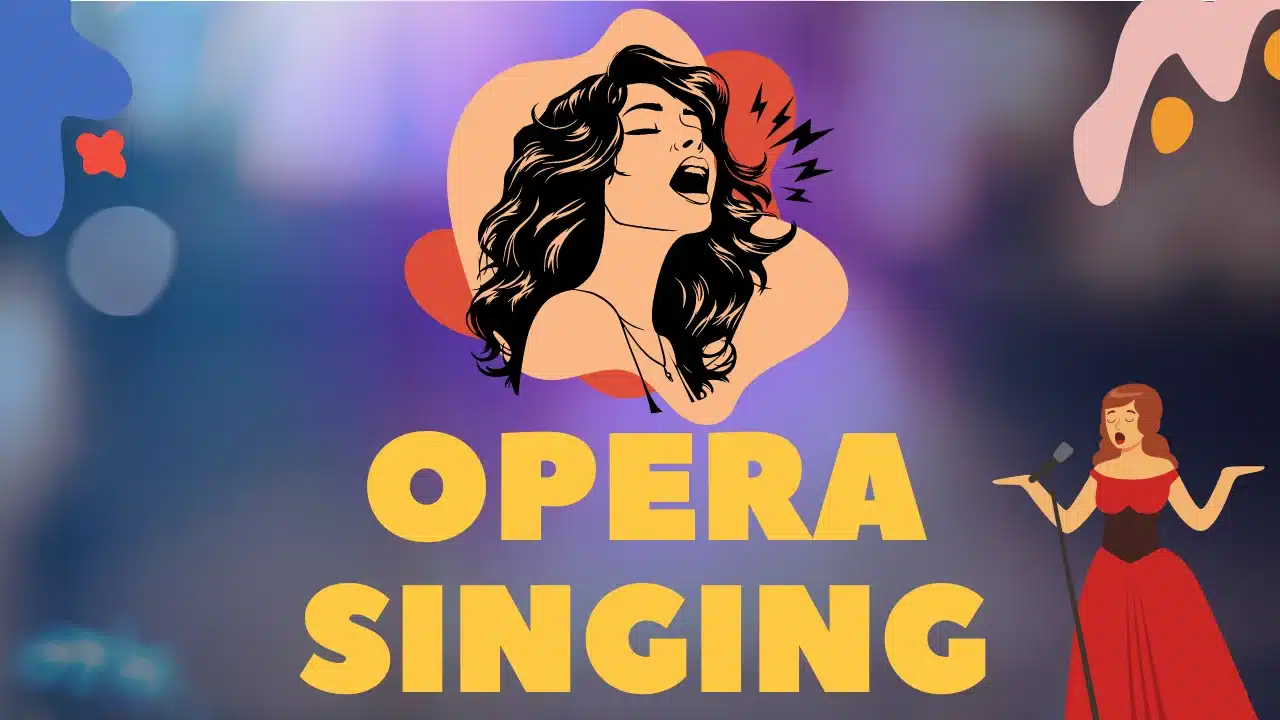I was about 12 years old when my vocal tutor taught me “O Mio Babbino Caro” by Puchchini and I began to know how beautiful a thing Opera singing is. Everyone says that opera singing lessons are complex and difficult. It kind of is, but I can assure you it’s practicable with the right training and techniques. There is something profoundly happy about watching famous opera singers perform with their angelic voices.
What is Opera?
Just before we get into the singing part, let’s look into “what opera is? a form of theater (performing art) in which singers take music and dramatic roles and perform. These singers mainly use the technique of Bel Canto. Different varieties of opera voice types come together and put on a show. Opera shows happen in opera houses with an orchestra accompaniment.
What is Opera Singing?
It can be a style of singing or a vocal performance in an opera production. It is defined as an art form encompassing drama, singing, orchestration and theatrical performance. This does make opera singing a complex artform yet once you try it there’s no going back. I’ve read a quote written by one of the famous opera singers.

In a way, being an opera singer is like a romantic 16 year old who falls in love with great passion – Renee Flemming
I was moved. I believe that opera singing is both an art and a discipline. It involves various techniques and disciplines. Here are a few most important techniques to look into for effective and emotive performances. Moving on to Opera singing technique.
Key Components of Opera Singing Techniques
Resonance
Finding the correct sound is easier said than done. Opera singing lessons begin from ‘vocal placement’. This technique explains where and how the sound resonates in your body.(vocal tract, head etc.) Some opera voice types use their head resonance completely and some their chest resonance. Proper vocal placement enables proper resonance which in turn produces fuller sound.
Relaxed muscles and open throat enhances resonance. I was trained to concentrate on the vibration in my face area to check for the ‘how and where’ the sound resonates.
Breath Support
I cannot stress enough how important breath support is in opera singing. You should watch some videos famous opera singers perform and observe how their body movements while breathing. They make it look so easy!
Singers use diaphragmatic breathing to control the flow of air, movements and richer vocal dynamics. I won’t lie, opera singing requires so much stamina and longer hours of practice. It is diaphragmatic breathing among other techniques that makes this style of singing grandeur. It also enables maintaining a consistent tone and hitting high and low notes with proper support.
Vocal Agility
Yet another technique that opera singing lessons include is Vocal Agility. Opera singing requires quick movements and wider vocal range to sing or sustain notes comfortably. Smooth transition between the notes is what makes your performance richer.exercises such as scales, arpeggios and runs help in improving vocal agility.
Projection of Voice
In the early days, opera houses did not have microphones to amplify the sounds. Famous opera singers had to project their voice out to a larger audience over the orchestral sounds. Powerful voices are required in opera singing while maintaining a tonal quality.
Dynamics
We know that dynamics enhance emotional expressions in any genre of music. Operatic modulations require volume control from soft to loud or loud to louder depending on the dynamic markings specified by the composers. More dynamic movements bring more emotional expressions.
Vocal Health
Opera singing lessons include detailed guidance on maintaining good vocal health with proper warm-ups and Cool-down and other techniques to avoid vocal strain or any injury. Proper posture is also a good way to avoid tension in muscles.
Developing Repertoire
Once we’ve covered the basics of opera singing and learning which opera voice type, developing proper and a suitable repertoire. Here the opera singing lesson would consist of coaching on arias and recitatives along with opera singing techniques.
Articulation
Opera singing requires clear articulation to ensure that every word is heard out clearly no matter which language it is in, owing to vertical singing. Understanding the languages and pronouncing the words clearly is also important. Most of the best opera arias are written in German, Italian or French.
Understanding Opera Singing Style
In the late 16th century, Opera singing originated in Italy. It’s interesting to note that a small group of musicians who called themselves “Florentine Camerata” tried to convey a Greek tragedy through music. This was the beginning of Opera.

Did You Know?
A music composer named “Claudio Monteverdi” created the first opera called L’Orfeo in 1607.
The Baroque Era
Composers like Handel and Vivaldi contributed greatly towards developing Opera and Opera singing. These composers started music in writing recitative and aria forms. Recitatives are the narratives that are spoken with expression and arias are more structured melody work.
You must listen to Handel’s one of his exceptional creations called “Judas Maccabaeus”. It is an oratorio with recitatives and arias.
Composers used Ornamentations like runs, trills and melismas to make the art of opera singing beautiful and interesting. These ornamentations brought out the virtuosity of the famous opera singers like Cazzini and Strozzi in the baroque period.
Hold on to your hats! This was not all! Da capo arias made quite the buzz in the Baroque era. The singer would sing the opening passage again following a contrasting middle section. This allowed for a great deal of improvisation.
The Classical Era
When I say classical era, I mean the time between 1700-1820. Classical period had some of the best known music composers like Mozart, Haydn or Gluck. They brought in some significant changes in technicality, in opera singing. Some of the best opera arias we learn in opera singing lessons are from the classical era. It emphasized the clarity of ornamentations introduced in the baroque and lyrical tone. Two more forms of opera – Opera Buffa(comedic opera) and Opera Seria (dramatic opera) were introduced in this era.
Mozart’s “The Magic Flute” was one of the most interesting and exemplary works of the classical era.
Romantic Era
Romantic era’s opera singing placed a strong emphasis on elaborate orchestration and emotional depth. Composers like Verdi, Wagner, and Puccini incorporated dramatic themes and intricate productions. Opera singing lessons had to incorporate lessons for widening vocal ranges to handle dramatic climaxes and long passages. One could say Vocal flexibility with more elaborate ornamentation of opera voice types was a hallmark of this era.
La Boheme is one of the best ontorios of Puccini. But “O Mio Babbino Caro” from Mariah callas is my favorite.
New forms and inspirations emerged in the 20th century. Composers of today are experimenting with new musical languages and topics, all the while honoring the rich historical traditions that are unique to their own nations. As a result, modern opera singing is always evolving.
Opera Voice Types
These voice types are categorized based on the tone, timbre and other factors that are suitable for any operatic repertoire. Let’s look into what type of voice is used in opera?
Soprano
There are lyrical, dramatic, coloratura and coloratura sopranos are the opera voice types in soprano. These singers’ voices range from C4-D6.
Mezzo Soprano
Lyrical and dramatic Mezzo-Soprano are the kinds of mezzo sopranos. These opera voice types range between A3 and A5.
Alto
Altos and Contraltos have vocal ranges between E3 and E5. These voice types have a deep, powerful resonant timbre.
Tenor
Just like the sopranos, tenors are lyrical and dramatic. Their vocal range is between C3 and B4. They have a strong and bright timbre.
Baritone
Baritones were called Helden Tenors (vocal range from B2-C5). These opera voice types are suitable for dramatic roles.
Countertenor
Countertenors sing in alto and mezzo-soprano’s range.(G3-D5). They have light and agile voice quality.
Bass
Lyrical, dramatic basses can be seen in opera singing. (E2-E4). Basso Profondo is another opera voice type whose vocal range ranges between C2 and D4. They have the deepest and powerful voice timbre.
Vocal tutors will help you determine which opera voice type you belong to. It is possible that learning opera singing lessons can take you for a ride, so tutors at MUSICMASTER can help you learn this type of artform in an easier way.
FAQs
What is opera singing?
It is a style of vocal performance using western classical techniques.
How to sing opera?
Mastering classical techniques, practice voice projection, clear diction and practicing arias is a best place to start.
What are the different voice types in opera?
Soprano, mezzo soprano, alto, contralto, tenor, baritone, bass are the opera voice types.
How can I improve my opera singing technique?
To improve your opera you must practice voice projection, clear diction and practicing extensive arias.
What are some famous opera arias for beginners?
24 arias by Schubert are best for beginners.
How do I find a good opera singing teacher?
You can learn with some of best of opera singers in music master. Book a free demo with MUSICMASTER
How do opera singers project their voices without microphones?
Opera singers project their voices without microphones by mastering vocal agility.
Who are some famous opera singers?
Luciano Pavarotti, Maria Callas, Placido Domingo Joan, Sutherland, Jose Carreras, Renee Fleming, Leontyne Price are some of the famous opera singers.
Realated blog: Taylor Swifts Hits








































